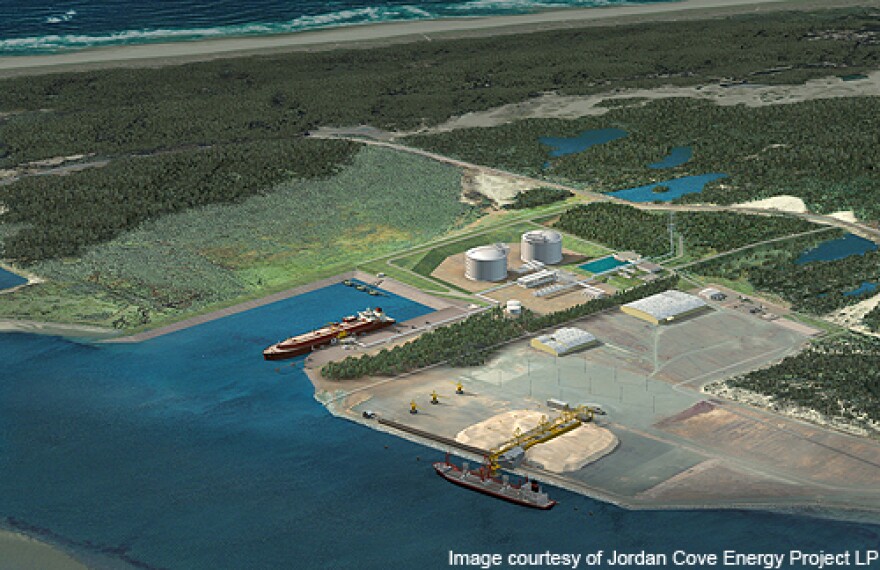There is so much natural gas coming out of the ground in North America that companies are looking for ways to get it to growing economies in Asia and beyond.
One of these companies wants to make Oregon the first place on the West Coast to export natural gas.
But before construction can begin, federal energy regulators must size up the environmental consequences.
The Jordan Cove Energy Project would start with a pipeline carrying natural gas more than two hundred miles from south-central Oregon to a coastal port town: Coos Bay.
There, developers want to build a power plant to turn the gas into liquefied natural gas – LNG. The LNG would go into tanks and get shipped across the Pacific Ocean.

Martin Callery is chief commercial officer with the Port of Coos Bay. On a clear blustery day near the site of the proposed facilities, he’s happy to talk about the upside of exporting LNG.
Callery: “For this community, having lost as much as they have, in terms of well-paying industrial, manufacturing jobs, primarily in the wood products sector — those jobs are critical to the future of this community.”
Callery says he’s confident the project will deliver benefits without doing ecological harm to Coos Bay.
Callery: “I think for the community overall, it’s a safe project. I’ve read all about it in the last ten and a half years, and I don’t see an issue with it.”
With the federal government soon to weigh in on the project’s potential impacts, the environmental debate is ratcheting up.
Cameron La Follette is with the Oregon Coast Alliance. She says building this new facility could stir up decades’ worth of pollution already beneath the waters of Coos Bay.
A decommissioned boatyard is about six miles from the proposed site of the LNG project. It would have been listed as a federal Superfund site in the 1990s -- but the State of Oregon took over the cleanup instead.
La Follette says state officials haven’t done enough in terms of cleaning and monitoring the polluted site.
La Follette: “There’s already contamination, incomplete cleanup, and incomplete information — because adequate monitoring hasn’t been done as required by the 1998 agreement.”
And La Follette says things could get worse if the bay is dredged deeper and wider.
La Follette: “The dredging that would have to take place in actual Coos Bay for these LNG tankers would completely destroy what remains of these underwater estuarine and marine habitats.”
Port official Martin Callery says such concerns are unfounded, with no potential for contamination from either the dredging or the increased marine activity.
But for a project of this magnitude, the environmental concerns arise from all corners of the region.
Take the proposed natural gas pipeline route. It crosses mountain ranges and the Pacific Crest Trail, along with many streams and rivers. That includes the Rogue River near the town of Shady Cove, about 130 miles inland.

Forrest English is program director of Rogue Riverkeeper. He stands above where the pipeline would cross the river.
“This would clear substantial amounts of streamside forests that salmon depend on to keep the water cold. Salmon need clean and cold water.”
English is concerned about the drilling required to place the pipeline below the Rogue River. If it doesn’t go perfectly, English says mud and drilling fluids could spill into the water.
English also worries that the natural gas pipeline itself might rupture – something that happened in California in 2010. That explosion lead to federal felony charges for safety violations that were announced this month.
Michael Hinrichs is a representative for the Jordan Cove Energy Project. He says this pipeline is safer. It will be built with updated technology and take into account the specific concerns of Northwest geography.
Hinrichs: “Safety is the highest standard when constructing and operating a pipeline, so we certainly will do our best.”
The draft report of Jordan Cove’s Environmental Impact Statement is expected in May, with a public comment period to follow.
By the end of the year, the government could release its final decision on the natural gas project in Southern Oregon.
Copyright 2014 Earthfix



